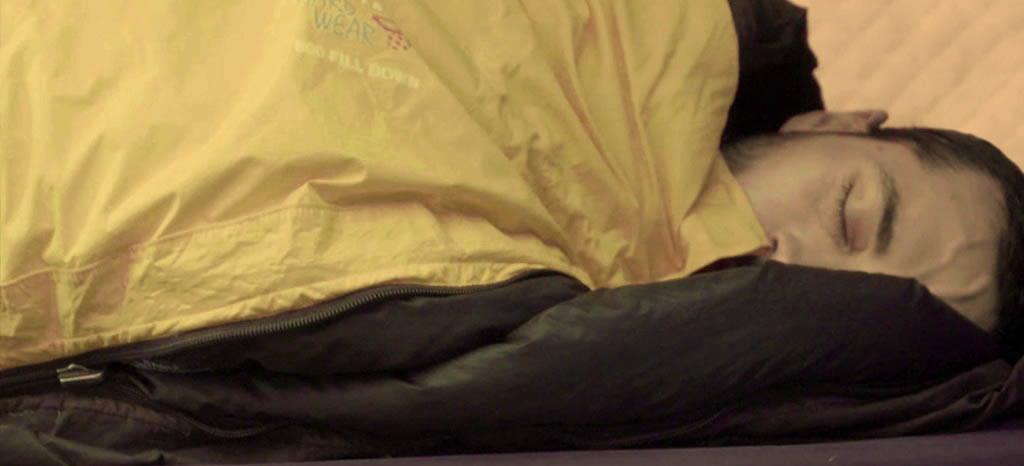FROM THE SECTION:

For our Mt Aconcagua expeditions, it is important to choose a ‘high mountain’ sleeping bag which is sufficiently warm and will retain the warm air layer that our body generates. We recommend DUVET filled with at least 850 to 1200 gs. It should be in the temperature range between -20 ° C / -30 ° C. The duvet is by far the most effective insulation, keeping you warm as well as being low in weight.
The outer fabric of the sleeping bag
Once we know the temperature, and we have the filling that works the best for us, we can choose the outer fabric. The best choice will be lightweight and durable as well as providing maximum protection from moisture entering, keeping snow, water, wind out. Waterproof and breathable fabric, (like goretex, Powertex, conduit) provides better protection, with very good breathability, while increasing the temperature range of the bag about 5 ° C. Sleeping bags with such fabric are slightly more costly and heavy.
Construction
To maintain a uniform thickness as well as preventing the duvet to accumulate on the bottom, sleeping bags are manufactured in partitions (either vertical or diagonal), the width and depth of the walls have a direct connection. Most manufacturers use a mesh, both light and elastic, which prevents down migration for a consistent performance.
Parts of the sleeping bag:
- Hood: It must fit the head to minimize air leakage, is best if it fits over the face to retain the hot air.
- Side flaps: Side tubes inside the sleeping bags at the end of the zipper are another important piece because, if there are points where the warm air can escape, we can then become cold. It is important that they have directional draft tubing to eliminate zip draft.
- Zippers. – They must be double action which will regulate the temperature by opening a little bit at the bottom. If they have any type of lock it will make it difficult to leave the bag in case of emergency. A Velcro closure on the part near the face is effective as it prevents unintentional opening.
- Base. – A broad base will allow us to sleep with thick socks/inner boots.
Mummy Sleeping Bags
The less air space there is to heat, the faster you warm up and stay warm. Therefore, the better it fits your body the better it works. Although some people can feel claustrophobic inside, a solution is to choose a slightly larger size to feel free to rotate and move at night or to be able to fit comfortably with clothes and boots.
This is why is essential to try and find out if the measurements as some models have extra padding in parts. there is no point having the best sleeping bag if you do not have good insulation, because the heat will be lost by conduction through contact with the ground.
TEMPERATURES
Let’s start by saying that in terms of temperature ranges there will always be variations from different brands, but fortunately many manufacturers are adhering to the European standard EN 13537 which will give you more reliable temperatures.
* The standard EN 13537 provides a method for measuring the temperature levels based on a thermal test on a manikin divided into 20 sectors on which different temperatures are measured separately, based on these four values of temperature values are determined, below we provide a definition:
- Maximum temperature: is the maximum temperature at which a medium size male (80kg) can spend a night in comfortable conditions without sweating.
- Comfort temperature: is the temperature level at which a medium size woman (60kg) can spend a night in comfortable conditions.
- Temperature limit: indicates the minimum temperature limit in which a medium size male (80 kg) can spend a night in comfortable conditions.
- Extreme temperature: corresponds to the temperature level at which a medium size woman (60kg) can spend a night without physical damage.
It is also important to note that in practice there are multiple individual-specific factors that can vary the temperature ranges:
- The metabolism of each person is an important factor. A thin person will need a warmer sleeping bag than a person with more fat or or muscle.
- The diet
- The physical condition e.g. exhaustion
- The clothes you sleep in
- The altitude
- The outside temperature
- The humidity
- The wind, even the slightest gust of wind can contribute to heat loss
- The tent insulation
According to a study, gender difference does not affect heat loss, the body type, differences in metabolism and circulation between men and women are insignificant when compared to the physical differences. Basically small things cool faster than the larger and more peripheral parts of the body, this is the reason toes lose heat before the legs. Body fat percentages also influence this.
There are four physical factors of HEAT LOSS to consider when sleeping in a sleeping bag:
Evaporation
Moisture or perspiration evaporates and produces the sensation of cold. Wearing breathable clothing is the best option to prevent this factor.
Moisture or perspiration evaporates and produces the sensation of cold. Wearing breathable clothing is the best option to prevent this factor.
Thermal radiation
The body radiates heat outwards when surrounded by a cold environment, this is reduced with a layer of trapped dead air around the body to keep the user warm and reduce body heat loss.
The body radiates heat outwards when surrounded by a cold environment, this is reduced with a layer of trapped dead air around the body to keep the user warm and reduce body heat loss.
Conduction
Basically we talk about heat exchange between two objects, the hottest transmits heat to the coldest. As the ground is always the colder we will convey our heat to it, this is solved with a good insulator.
Basically we talk about heat exchange between two objects, the hottest transmits heat to the coldest. As the ground is always the colder we will convey our heat to it, this is solved with a good insulator.
Convection:
The heated air usually disperses and is replaced by cold air, cooling us down again. This depends on the temperature and the speed with which the new air arrives. A good thermal collar in the sleeping bag or bivy prevent convection. In hotter situations convection can be very helpful because it produces coolness, this is when we appreciate having chosen a good sleeping because if we have a double zippered sleeping we can open it a bit to cool the feet.
The heated air usually disperses and is replaced by cold air, cooling us down again. This depends on the temperature and the speed with which the new air arrives. A good thermal collar in the sleeping bag or bivy prevent convection. In hotter situations convection can be very helpful because it produces coolness, this is when we appreciate having chosen a good sleeping because if we have a double zippered sleeping we can open it a bit to cool the feet.
The function of a sleeping bag is not to heat up but to retain the warmth of your body and avoid losing this warmth as best as possible.
Recommendation:
You must choose your sleeping bag based on the lowest temperature you expect to experience, which must match with the COMFORT TEMPERATURE thats marked by the manufacturer.
TIPS
- When the bag is not in use, you should leave it open and hanging. If you do not have the necessary space it can be kept in a bag. It must only be compacted during travel and for the least possible time.
- Always try to hydrate and eat before bedtime.
- Always use a good insulating mat under your sleeping bag. This provides the insulation under you and keeps you from the cold, moisture and dust on the floor.
- When storing your sleeping bag in the compression bag, it must not be twisted. Pack it in starting with the feet area first as this is best for the filling, this is also easier to do it this way in the mountains.
- When entering the inside the bag, try and be as dry as possible and also if possible enter after exercise as it will conserve some of the heat generated, otherwise it will take longer to heat the air in the bag.
- If you stay a few days in camp is recommended to dry the sleeping bag in the sun to remove the moisture produced by sweat.
